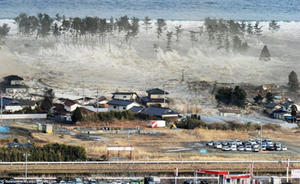Disaster in JapanSensors detecting nuclear tests detect tsunamis, too
The Comprehensive Nuclear test-Ban Treaty (CTBT) is supported by arrays of sensors at sixty sites across the world that listen for the low boom of atmospheric blasts. They are tuned to infrasound — frequencies under 20 hertz (cycles per second), the lowest humans can hear; these sensors are meant to pick up illicit nuclear tests, but they can also pick up tsunami-producing tremors — and provide timely warning to those likely to be affected

Seawater rushes inland as tsunami strikes // Source: japan-zone.com
Currently it is a matter of pure guesswork whether a submarine earthquake is going to produce a tsunami. A treaty banning nuclear tests, however, may change that, if the treaty itself does not expire first.
The Comprehensive Nuclear Test-Ban Treaty (CTBT) was signed in 1996 but has not yet come into effect, mostly because the United States has not yet ratified it — although President Obama wants Congress to do so. New Scientist reports that, meanwhile, a worldwide network of seismographs and other sensors designed to detect nuclear blasts listens for any tests. It also gives fast, reliable warnings of earthquakes. The Comprehensive Nuclear Test-Ban Treaty Organization monitoring centre in Vienna, Austria, spotted the Japanese quake, and alerted Indonesia and other governments to the quake off Sumatra that caused the 2004 Boxing Day tsunami. It can also do other things, too.
The system includes arrays of sensors at sixty sites across the world that listen for the low boom of atmospheric blasts. They are tuned to infrasound — frequencies under 20 hertz (cycles per second), the lowest humans can hear.
Bombs are not all they can hear — they also pick up volcanoes, and even rogue waves in the north Atlantic.
In 2009 the CTBT’s scientists reported that their station on the Indian Ocean island of Diego Garcia had picked up infrasound from big quakes in Sumatra in 2004, and Mantawi and Nias Island in 2005. The first two produced tsunamis; Nias did not. The first two also made a characteristic groan at 60 hertz near their epicentres. Nias did not.
Milton Garces of the University of Hawaii at Manoa thinks this might be used to make a tsunami warning system. The infrasound signals generated by the tsunami-making quakes travel at up to 330 meters per second, while the tsunamis themselves propagate at about 260 meters per second. So the sound signal should arrive at a monitoring station before the wave hits.
He recorded these sounds from the 2004 Boxing Day quake. The first sound is the earth moving. The second is an echo of the sound of the earth that travelled through the ocean. The third is the signal generated by the production of a tsunami. No one knows yet what process gives rise to the noise.
Further research is under way — but the infrasound network being used to do it is under threat: the longer the CTBT remains unratified, the less enthusiastic governments are to keep funding it.
